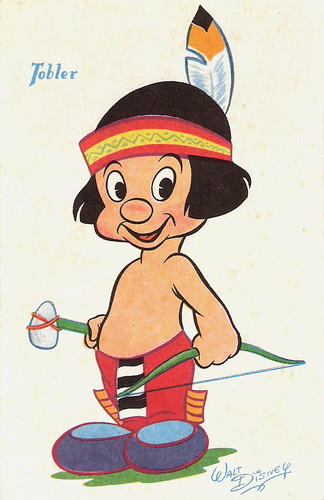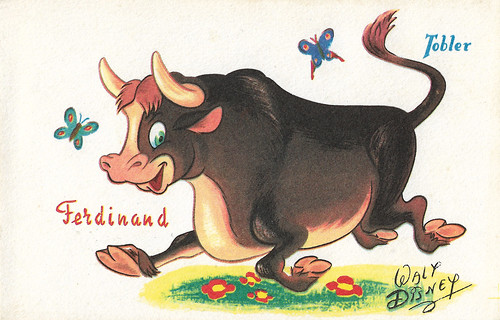
French postcard by Imp. Georges Lang, Paris, offered by Chocolats Tobler. Image: Walt Disney.
Fifer Pig and Fiddler Pig are two of the three little pigs of the classic Silly Symphonies short Three Little Pigs (Burt Gillett, 1933). The Three Little Pigs (1933) was phenomenally successful with audiences of the day, so much so that theatres ran the cartoon for months after its debut, to a great financial response. Several theatres added hand-drawn "beards" to the movie posters for the cartoon as a way of indicating how long its theatrical run lasted. The cartoon is still considered to be the most successful animated short ever made and remained on top of animation until Disney was able to boost Mickey's popularity further by making him a top merchandise icon by the end of 1934. The Three Little Pigs won the Oscar for Best Animated Short Film in 1934. In 1994, it was voted #11 of the 50 Greatest Cartoons of all time by members of the animation field. In 2007, The Three Little Pigs was selected for preservation in the United States National Film Registry by the Library of Congress as being "culturally, historically, or aesthetically significant".

French postcard by Imp. Georges Lang, Paris, offered by Chocolats Tobler. Image: Walt Disney.
Practical Pig is one of the three little pigs of the classic Silly Symphonies short Three Little Pigs (Burt Gillett, 1933) and its three follow-up shorts, The Big Bad Wolf (Burt Gillett, 1934), Three Little Wolves (Burt Gillett, David Hand, 1936), and The Practical Pig (Dick Rickard, 1939). The three pigs are constantly targeted by the Big Bad Wolf, who wants to eat them for dinner.

French postcard by Imp. Georges Lang, Paris, offered by Chocolats Tobler. Image: Walt Disney.
The Big Bad Wolf is the main antagonist of the Silly Symphonies short Three Little Pigs (Burt Gillett, 1933) and its sequels. As his name suggests, he is a ruthless, conniving wolf who constantly plots to capture and eat the Three Little Pigs.

French collector card, series 2, no. 2. Image: Walt Disney - Mickey Mouse. Scene from The Three Little Pigs (1933). Caption: 'We're going to play a dirty trick on him...!'

French postcard by Éditions F. Sépériadès, Paris, no. 2. Image: Walt Disney - Mickey Mouse. Scene from The Big Bad Wolf (1934). Caption: Along the way, Little Red Riding Hood passes by her friends' farmhouse.
The Big Bad Wolf (Burt Gillett, 1934) is an animated short produced by Walt Disney as part of the Silly Symphony series. Acting partly as a sequel to the wildly successful adaptation of the folk tale The Three Little Pigs (1933) and maintaining the previous film's title characters as well as its villain, this film also acts as an adaptation of the fairy tale 'Little Red Riding Hood' (1697) by Charles Perrault, with the Big Bad Wolf from Three Little Pigs acting as the adversary to Little Red Riding Hood and her grandmother.

French postcard by Éditions F. Sépériadès, Paris, no. 3. Image: Walt Disney - Mickey Mouse. Scene from The Big Bad Wolf (1934). Caption: Little Red Riding Hood and her little friends set off through the woods. 'Raccourci" translates as Shortcut.
Musical animated shorts that combined the latest sound technology with storytelling
While Walt Disney and Carl Stalling, a theatre organist from Kansas City, were in New York to add sound to the Mickey Mouse shorts The Gallopin' Gaucho, The Barn Dance and Plane Crazy, Stalling suggested the idea of making a series of musical animated shorts that combined the latest sound technology with storytelling. At first, Walt did not seem interested, but when they returned to New York in February to record the sound for a fifth Mickey Mouse cartoon, The Opry House, they also recorded the soundtrack for The Skeleton Dance, the type of short that Stalling had suggested and the first Silly Symphony cartoon.
Within the animation industry, the series is known for its use by Walt Disney as a platform for experimenting with processes, techniques, characters, and stories to further the art of animation. It also provided a venue to try out techniques and technologies, such as Technicolor, special effects animation, and dramatic storytelling in animation, that would be crucial to Disney's plans to eventually begin making feature-length animated films.
Shortly after the switch to United Artists, the series became even more popular. Walt Disney had seen some of Dr. Herbert Kalmus' tests for a new three-strip, full-colour Technicolor process, which would replace the previous two-tone Technicolor process. Disney signed a contract with Technicolor which gave the Disney studio exclusive rights to the new three-strip process through the end of 1935 and had a 60% complete Symphony, Flowers and Trees, scrapped and redone in full colour. Flowers and Trees was the first animated film to use the three-strip Technicolor process and was a phenomenal success. Within a year, the now-in-Technicolor Silly Symphonies series had popularity and success that matched (and later surpassed) that of the Mickey Mouse cartoons.
The contract Disney had with Technicolor would also later be extended another five years as well. The success of Silly Symphonies would be tremendously boosted after Three Little Pigs was released in 1933 and became a box office sensation; the film was featured in movie theatres for several months and also featured the hit song that became the anthem of the Great Depression, 'Who's Afraid of the Big Bad Wolf'. Several Silly Symphonies entries, including Three Little Pigs (1933), The Grasshopper and the Ants (1934), The Tortoise and the Hare (1935), The Country Cousin (1936), The Old Mill (1937), Wynken, Blynken, and Nod (1938), and The Ugly Duckling (1939, with an earlier black-and-white version from 1931), are among the most notable films produced by Walt Disney.
Due to problems related to Disney's scheduled productions of cartoons, a deal was made with Harman and Ising to produce three Silly Symphonies: Merbabies, Pipe Dreams, and The Little Bantamweight. Only one of these cartoons, Merbabies, ended up being bought by Disney, the remaining two Harman-Ising Silly Symphonies were then sold to MGM who released them as Happy Harmonies cartoons. Disney ceased production of Silly Symphonies in 1939.

Italian postcard by Grafiche Biondetti, Verona, no. 123. Image: Walt Disney Productions.
'Grandpa Bunny' (1951) is a classic Little Golden Book. It was inspired by the Technicolor Silly Symphony short, Funny Little Bunnies (1934).

French postcard by Imp. Georges Lang, Paris, offered by Chocolats Tobler. Image: Walt Disney.
Grandpa Bunny was introduced in the Silly Symphony Funny Little Bunnies (Wilfred Jackson, 1934). In the seven-minute short, bunny rabbits are preparing for Easter by making chocolate eggs, rabbits decorating eggs, and weaving and filling baskets. In 1951, Grandpa returned in the Little Golden Book 'Grandpa Bunny'. It tells the touching story of (now) Great-Grandpa Bunny Bunny, who teaches each new generation of bunnies how to prepare for the coming spring. The story was told by Jane Werner with illustrations by the Walt Disney Studio adapted by Dick Kelsey and Bill Justice from Funny Little Bunnies (1934). Cole Sear at IMDb about the short: "Funny Little Bunnies is whimsical Disney animation at its best and it is unapologetically funny. (...) The story is simple and humorous without being too dumb and the animation- which I suspect was done on 3-strip technicolour is beautiful."

French postcard by Tobler. Image: The Walt Disney Company.
Elmer is the main character of the Silly Symphonies short Elmer Elephant (1936), produced by The Walt Disney Company, and directed by Wilfred Jackson.

French postcard by Imp. Georges Lang, Paris, offered by Chocolats Tobler. Image: Walt Disney.
Little Hiawatha (or simply Hiawatha is a little Indian hunter who hunts for the game. He is the hero of the Silly Symphony Little Hiawatha (David Hand, 1937). In the short film, Hiawatha is first seen rowing in his canoe across the canoes across the falls of Minneha'ha. Encountering a bluebird and a robin, he prepares to fire his arrow but the animals tell them not to hurt them. Upon passing through a whirlpool, Hiawatha arrives at a stop and falls on the water where the raccoons, rabbits, squirrels, and other woodland creatures laugh at him. Approaching the animals, Hiawatha tries to fire his arrow at them but they end up running away. Hiawatha sees strange animal tracks to which he sees a grasshopper he is about to hunt. Hiawatha attempts to take him down but the grasshopper fools him and later chases a small rabbit which surrounds him as he attempts to take him down but instead shoos him away. The rabbit is reunited with his family due to his big heart, as he spares the innocent rabbit. Upon sparing the rabbit, Hiawatha breaks his arrow as the animals cheer for him that he will not harm any other animal he encounters. He accidentally encounters a bear cub alongside an adult bear which suddenly chases him across the woods while three beavers notice that Hiawatha is in danger sounding the alarm to the woodland creatures. As Hiawatha is being chased, the raccoons, beavers, opossums, and other animals manage to save him from the bear. He then returns to his canoe as the animals bid farewell to him.

French postcard by Imp. Georges Lang, Paris, offered by Chocolats Tobler. Image: Walt Disney.
Little Hiawatha (or simply Hiawatha is a little Indian hunter who hunts for the game. He is the hero of the Silly Symphony Little Hiawatha (David Hand, 1937).

French postcard by Imp. Georges Lang, Paris, offered by Chocolats Tobler. Image: Walt Disney.
Ferdinand is the quiet, gentle bull who, instead of being fierce in the bullring, only wants to smell the flowers in Disney's animated short Ferdinand the Bull (Dick Rickard, 1938). When he is stung by a bee, the townspeople believe he is ferocious and they take him to the bullfight. Ferdinand was voiced by animator Milt Kahl.
Source: Wikipedia.
No comments:
Post a Comment